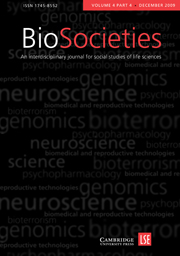We are especially pleased that this issue of BioSocieties includes several articles that extend the boundaries of social analyses of the life sciences into new and developing arenas. The first article continues our investigation of the forensic uses of DNA, but takes us into different national territory: Portugal. In the context of arguments for the need to refocus informed consent vis-à-vis risks and uncertainties, Helena Machado and Susana Silva examine Portuguese practices of informed consent in collecting DNA samples for forensic use. The second article by Tiago Moreira and Paolo Palladino similarly explores a territory that has been only lightly travelled by bio-social theorists: aging. The authors review critiques of the current ‘biomedicalisation of aging’, drawing attention to the hybrid character of biomedicine and sources of uncertainty within biogerontology itself. Yet another article, by Carrie Friese, takes us into entirely novel and fascinating territory: the zoo. Friese explores the question of the nature of animal models through an ethnographic study of the practices embodied by cloned endangered animals arguing that these animals are both models of an interspecies variety of somatic cell nuclear transfer as well as models for conducting science in zoological parks. Continuing our series of ‘country reports’, Suli Sui describes the practice of genetic counselling in China, and draws out some of its key distinctions from the practices in Europe, locating these in the specific administrative, political and socioeconomic environments in Chinese society, notably the different organisations of professions and the lack of full healthcare coverage. Our final two papers focus on issues arising in contemporary neuroscience. Beatrix Rubin analyses the emergence of the belief that the human brain is ‘plastic’ up to and throughout adulthood, using the focus of adult neurogenesis—the de novo formation of neurons in the mature brain—to explore the controversies surrounding the transition from a view of the mammalian brain as structurally stable to this new ‘thought style’ emphasising neuroplasticity. Finally, Francisco Ortega examines the rise of the neurodiversity movement in autism—the argument by those living under this description that their condition is not a disease to be treated or cured, but a different way of living to be respected, and indeed one that has certain advantages over the forms of life of ‘neurotypicals’—raising key issues of the extent to which, in our neurobiological age, identities are being reframed in cerebral terms.
We have some exciting announcements to make in this final issue of the year, and we bid two farewells. We would like to say a heartfelt thank you to Anne Harrington, who has served as Co-Editor of BioSocieties since the first issue, and whose wisdom, energy and patience helped create the foundations of the journal and gave it forward momentum. At the same time we welcome our new Co-Editor, Adele Clarke. We are so pleased that Adele agreed to join us in steering BioSocieties into the 20-teens; she brings a wealth of experience from a rich intellectual career and great enthusiasm to the job. We also bid farewell to Javier Lezaun, our Books Forum Editor, who brought vision and commitment to the Forum and gave us fantastic reviewers and reviews. Nicolas Langlitz will follow in Javier’s footsteps as Books Forum Editor, and we already know that he will bring innovation and inspiration to this important dimension of our journal.
This is also the final issue of BioSocieties to be published by Cambridge University Press: from Volume 5, our journal will be published by Palgrave Macmillan. The editorial team would like to take this opportunity to thank our colleagues at CUP for their generous support from the inception of the journal, and its development into publication, and over the past four years. To our readers, we assure you that the Journal will continue to thrive under the new publishing arrangements, and we look forward to outlining further new developments in our next issue.
Adele E. Clarke
Nikolas Rose
Ilina Singh


